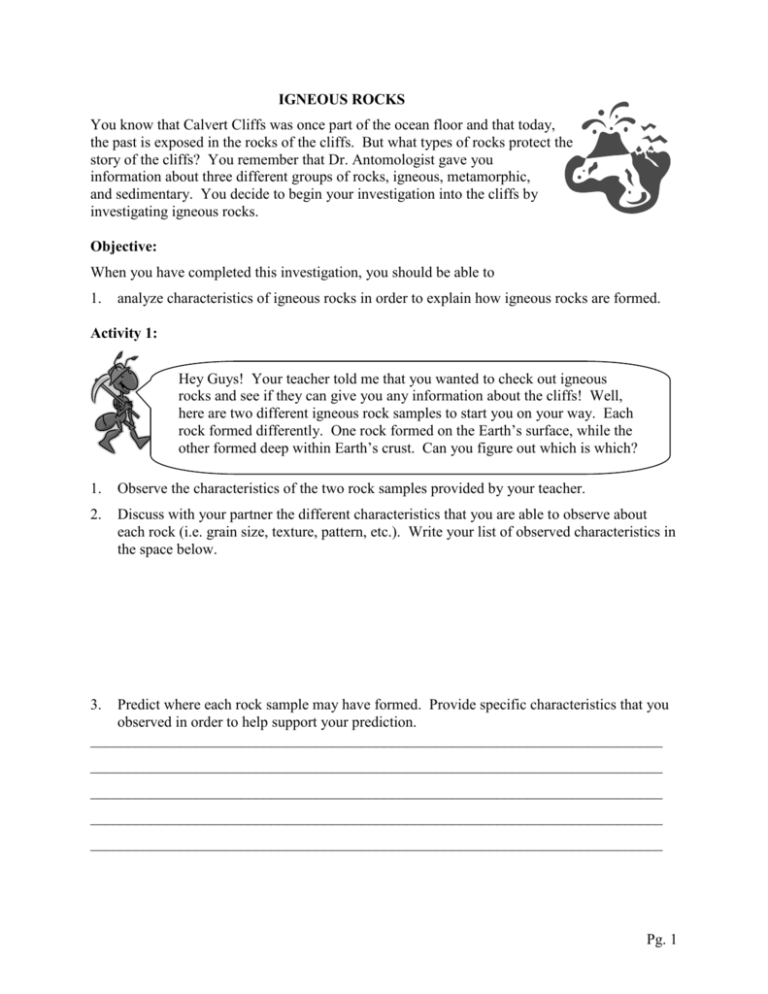IGNEOUS ROCKS
advertisement

IGNEOUS ROCKS You know that Calvert Cliffs was once part of the ocean floor and that today, the past is exposed in the rocks of the cliffs. But what types of rocks protect the story of the cliffs? You remember that Dr. Antomologist gave you information about three different groups of rocks, igneous, metamorphic, and sedimentary. You decide to begin your investigation into the cliffs by investigating igneous rocks. Objective: When you have completed this investigation, you should be able to 1. analyze characteristics of igneous rocks in order to explain how igneous rocks are formed. Activity 1: Hey Guys! Your teacher told me that you wanted to check out igneous rocks and see if they can give you any information about the cliffs! Well, here are two different igneous rock samples to start you on your way. Each rock formed differently. One rock formed on the Earth’s surface, while the other formed deep within Earth’s crust. Can you figure out which is which? 1. Observe the characteristics of the two rock samples provided by your teacher. 2. Discuss with your partner the different characteristics that you are able to observe about each rock (i.e. grain size, texture, pattern, etc.). Write your list of observed characteristics in the space below. 3. Predict where each rock sample may have formed. Provide specific characteristics that you observed in order to help support your prediction. ____________________________________________________________________________ ____________________________________________________________________________ ____________________________________________________________________________ ____________________________________________________________________________ ____________________________________________________________________________ Pg. 1 Activity 2: Now that you’ve had a chance to observe some of the characteristics of igneous rocks, you’ll need more information about their formation in order to determine if they could have affected the formation of Calvert Cliffs. Use resources provided by your teacher to gather the following information about igneous rocks: From what materials do igneous rocks form? How are igneous rocks classified? What’s the difference between intrusive to extrusive igneous rocks? How does cooling rate affect the grain size of igneous rocks? 5. Record specific information that you gather on the graphic organizer, “Igneous Rock Formation.” 6. Use the information that you gathered and Figure 1 to answer the following questions. B Earth’s surface Volcanic layers A Figure 1 A. Lava is found at _________ and magma is found at __________. A, B A, B B. Magma cools ______________________ because it is __________________________. quickly, slowly under the ground, on Earth’s surface C. Igneous rocks with large crystals form from _________________________ whereas lava, magma igneous rocks with small or no crystals form from ____________________. lava, magma Pg. 2 Activity 3: Think you know enough about igneous rocks to identify them? Use what you’ve researched about igneous rocks to identify the different rock samples I’ve sent to your teacher. Good Luck! Materials (per group): Various igneous rock samples Hand lenses Dichotomous key for igneous rocks Procedure 1. Read “Identifying Igneous Rocks.” IDENTIFYING IGNEOUS ROCKS A. Obtain the rock samples from your teacher. B. Use the dichotomous key to identify the igneous rocks based on their observable characteristics. C. Place the rocks in the appropriate space on the dichotomous key when you think you have correctly identified each rock. D. Ask your teacher to verify your identification of each rock. E. Determine if each rock was most likely formed from magma or lava. (HINT: use grain size/crystal size to help you make your decision. F. Record your decision in Chart 1, “Classifying Igneous Rocks.” G. Identify the rocks as either intrusive or extrusive by placing an “X” in the appropriate column. 2. Reread the procedures and explain how the dichotomous key will be helpful in classifying the different rock samples. ____________________________________________________________________________ ____________________________________________________________________________ ____________________________________________________________________________ 3. Conduct the investigation. Pg. 3 Chart 1: Classifying Igneous Rocks Rock Formed from Magma or Lava Cooled Slowly (Intrusive) Cooled Rapidly (Extrusive) Andesite Basalt Diorite Gabbro Granite Obsidian Pumice Rhyolite Analysis 1. Make a general statement about how igneous rocks are formed. Use evidence from the investigation to help you write your statement. ____________________________________________________________________________ ____________________________________________________________________________ ____________________________________________________________________________ ____________________________________________________________________________ 2. Explain how the cooling rate of molten material affects the formation and the grain size of igneous rocks. Provide examples from the investigation to support your response. ____________________________________________________________________________ ____________________________________________________________________________ ____________________________________________________________________________ ____________________________________________________________________________ ____________________________________________________________________________ Fossil Fact: Determine if it would be possible for the fossils of Calvert Cliffs to have formed in igneous rocks. Pg. 4 Forms from _______________________ (molten material inside the Earth) Classified As _______________________ (molten material on the Earth’s surface) Classified As Intrusive or Extrusive Intrusive or Extrusive (circle one) (circle one) Cools Cools Quickly or Slowly Quickly or Slowly (circle one) (circle one) Description of Grain Size Description of Grain Size Pg. 5 DICHOTOMOUS KEY FOR IGNEOUS ROCKS Are the rock grains the size of sand or smaller (need a hand lens to see)? YES NO Does the rock look like black, shiny glass? Does the rock contain pink, white, or black quartz (looks speckled)? YES NO Does the rock look porous (like a sponge)? YES YES NO Gabbro Diorite Obsidian Granite Is the rock mostly dark grey in color (no white)? NO Pumice Is the rock dark gray or black? NO NO Andesite YES NO Does the rock contain mostly pink or white quartz (looks mostly pink or white)? YES Basalt YES Rhyolite Pg. 6







